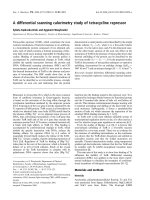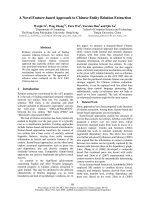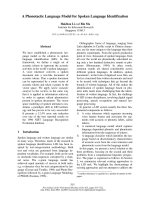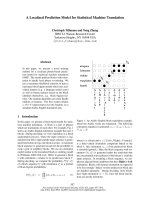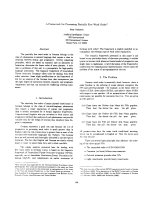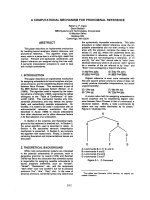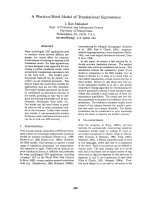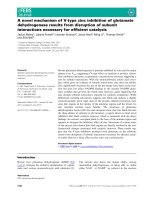Báo cáo khoa học: "A PREFERENCE MECHANISM BASED ON MULTIPLE CRITERIA RESOLUTION" ppt
Bạn đang xem bản rút gọn của tài liệu. Xem và tải ngay bản đầy đủ của tài liệu tại đây (592.79 KB, 6 trang )
A PREFERENCE MECHANISM
BASED ON MULTIPLE CRITERIA RESOLUTION
Yannis Dologlou
Eurotra-GR, Margari 22
11525 Athens, Greece.
Giovanni Malnati
Eurotra-IT, Gruppo Dima,
Corso F.Turafi ll/C
10128 Torino, Italy.
Patrizia Paggio
patrizia@ eurotra.uucp
Eurotra-DK, University of Copenhagen,
Njalsgade 80
2300 Kbh S, Denmark.
ABSTRACT
This paper presents an experimental preference tool
des!gned, implemented and tested m the Eurotra
pro)ect. The mechanism is based on preference rules
which can either compare subtrees pairwise or single
out a subtree on the basis of some specified con-
straints. Scoring permits combining the effects of
various preference rules.
THE PROBLEM
The aim of a translation system is to produce the
correct translation of a given text. In Eurotra, where
translation is split up into a series of mappings
among intermediate levels of representation, pro-
visional overgeneration is a necessary evil [Raw et
al. 1989]: the closer to surface structure a level of
representation is, the harder it becomes for the parser
to produce an unambiguous result. In the Eurotra
framework, the E-framework [Bech et al. 1989],
overgeneration can be partially controlled by filters
which describe parse trees that are to be discarded as
not obeying some specified constraints. Thus, filters
apply to individual objects and are meant to delete
inherently wrong representations. But there are cases
where the grammar produces multiple analyses of a
given input because the input is ambiguous with re-
spect to a given level. All of these analyses are in
some sense correct, although further processing
might discard some of them. Our aim was to design
a preference mechanism able to choose the best
among a set of acceptable candidates.
OUR VIEW OF PREFERENCE
Preference has been defined in a number of ways,
e.g. as a gradual fulfilment of semantic constraints
[Fass andWilks 1983], as a lexically induced syn~c-
tic bias [Ford et al. 1982], as a parsm[[ strategy in~-
pendent of linguistic criteria [Frazler and Fodor
1978, Pereira 1985], and as a system based on
multiple judgements reflecting the complexity of psy-
chological processes [Jackendoff 1985].
Our approach, which is greatly indebted to Jacken-
doffs theory of preference rule systems, is based on
the following assumptions:
- Preference is a method which, on the basis of
some preference criteria, chooses the best one
among a set of possible interpretations
which are all correct according to the
grammar.
- Each preference criterion is expressed as a set
of statements, where a statement is either a
binary relation between competing interpreta-
tions or the description of a subtree which
satisfies some defined criteria.
- There is no unique preference criterion accor-
ding to which the best interpretation can be
chosen: preference criteria are multiple, and
possibly contradictory. A preference mecha-
nism must be able to accommodate such multi-
~eCferYence criteria are heuristic principles
which may vary according to the language and
the text type: therefore, they are not hardwired
m the system.
In the previous Eurotra preference mechanism
[Petitpierre et al. 1987], preference statements
were only defined as binary relations between
subtrees. Since comparing subtrees is a rather
expensive operation from the computational point
of view, and since a number of preference cnteria
- e.g. the principle of right-low attachment -
cannot be expressed in binary terms, we have
allowed both binary and non-binary preference
rules. The applicaaon algorithm of p-rules and
the way in which various preference criteria are
combined are also new w~th respect to the pre-
vious system.
THE MECHANISM PROPOSED
The mechanism proposed is an independent
module which is activated on the results output
by the parser. The module consists of pre~r.ence
rules of two possible kinds, which we call tnnary
and unary rules.
A binary rule establishes a preference relation
between two correspondin~ (sub)trees (from here
on, (sub)tree will be used m the sense of a repre-
sentation of an interpretation or a part ot m~s
representation). A unary rule picks up a (sub)tree
on the basis of i~s own properties, thus implicitly
establishing a preference relation between this
(sub)tree and all its competitors. Each preference
rule - be it binary or unary - is associated with a
score, which is assigned to the preferred (sub)tree
as a result of the application of the rule.
- 281 -
Correspondences:
The notion of correspondence
between (sub)trees is central topreference rules of
the binary type. A number of def'mitions of this con-
cept can be envisaged:
i. The correspondence between two (sub)trees is
established by the user, who states that some
specified contraints hold between parts of them.
ii. A correspondence is only assumed to exist
between full parse trees, and the correspondence
between two subtrees is defined by specifying
their derivation paths from the top node.
iii. The system proauces a parse graph which will be
a synthesis of the various parse trees, where parts
common to several trees are shared; two subtrees
correspond if they share a given part.
The most challenging solution is (iii): we have not
adopted it because of computational problems con-
nected with the introduction of structure-sharing into
.the E-framework. The easiest solution to implement
(ii): this is the approach chosen in the earlier
urotra preterence tool. The solution we have
adopted ts (i), which unlike (ii) allows the user to
state constraints on subtrees, regardless of their
position in the complete parse tree. In other words,
our system allows for very local and modular state-
ments.
Preference Rules: The user expresses preference
statements through a set of binary or unary preferen-
ce rules (p-rules).
The syntax for a binary rule is
RuleName ( Score ) =
LHS >= RHS
where
Annotations.
where:
RuleName is a unique identifier used for trace
purposes;
Score is a positive integer which indicates how
strong the relation of preference is;
LHS and RHS (the left-hand side and the right-
hand side of the rule) are the descriptions of the
two (sub)trees to be compared;
-
>= is a preference sign that indicates which of the
two (sub)trees is to ~e preferred;
An.notations is a (possibly empty) set of constraints
wmcn must hold between the constituents of the
two (sub)trees to be compared.
The syntax for a unary rule is
RuleName ( Score ) =
LHS
where
Annotations.
where:
- LHS is the description of the (sub)tree to be
singled out (which we call the left-hand side to
stress the parallelism with binary rules);
- the other parts are as defined for binary rules.
LttS and RHS are (sub)tree descriptions of any
de.l~h and relevant parts of them may be labelled
wtm r'rotog variables, called indexes. These labels
are used to express simple or complex corresponden-
ce constraints in the annotation part of the rule. A
simple constraint states for instance that two
indexed subtrees must or must not have the same
structure. Simple constraints may be combined
with the operators 'and" and 'or' to form complex
constraints. Scores, which have the function of
driving p-rule interaction, are positive integers.
They may be either assigned by the user or
generated automaucally on statistical grounds, as
explained below. Examples of both rule types are
given in the appendix.
General Algorithm:
All theparse trees have
an initial null score before preference rules are
applied. For each pair of trees, if they contain
two subtrees respectively matching the LHS and
the RHS of a binary p-rule, while the constraints
in the annotation part of the rule hold, the rule
applies. Similarly, for each parse tree, if a subtree
matching the LHS of a unary b-rule can be
extracted, and all the constraints expressed in the
rule are satisfied, the rule applies. In both eases,
as a result of p-rule applicatton, the score of the
object that contains the preferred subtree is
incremented by the score of the rule.
When all binary rules have been tried out on
all the possible pairs of trees in all the possible
ways, and all unary rules have been fired on all
the single trees, results are collected. All parse
trees are partitioned into equivalence classes
according to their score. Note that trees to which
no preference rule has applied will belong to the
lowest-ranking class: this is motivated by the
assumption that unary rules prefer single trees
over all the other members of the set of compe-
ling trees.
After this partial order has been established, all
the trees but those belonging to the highest-
ranking class are discarded.
A possible enhancement to the expressive
power of p-rules would be the introduction of
negative scores, for cases where a p-rule
describes an acceptable but not totally correct
subtree.
AN EXAMPLE
The following set of p-rules are based on some
of the criteria for the treatment of PP attachment
described in [Hirst 1987]. Note that p-rule scores
have been assigned manually, due to the small
number of rules.
pmod (8) = {cat=pp, sf-=mod} [PI: {cat=p},
NPI: {cat=np}]
>= {cat=pp, sf=mod} [P2:{cat, p},
NP2: {cat=np}]
where PI=P2, NPI=NP2.
In the rule above, 0 delimit a node in the tree,
which in the E-framework is a set of attribute
value pairs, [] following a given node enclose its
daughters, = means equal to and ~= means
different from. The rule prefers a valency-bound
PP to a PP modifier. This is a very strong cri-
terion, which can only be overridden by semantic
principles: therefore, the rule has a high score.
- 282 -
plow (2)= {cat=nptt,[__, {cat=n],
## {cat=pp],
*{} ].
The rule gives 2 points to an attachment where a
PP is placed under an NP node. Note that *0 means
any number of (sub)trees, without any restriction,
and ~ in front of a subtree means that this subtree
is weakly dominated by the top node. Assuming the
following two structures
a)
NP
I
N
NP pp
b)
NP
I
N
NP
I
N pp
'plow' will only apply once to (a), but it would fire
twice on (b), which will in the end collect the
highest score. The rule implements in fact the
pnnciple of right-low auachment.
peoord (5) = {cat=?}
[el: {sf=conjunct},
C2: { sf=con]unct} ]
where width(C1) = width(C2).
The rule above assigns 5 points to a coordinated
structure where the two conjuncts have the same
number of terminals. Note that constraints are stated
between nodes of two com~ting (sub)trees and not,
as it was the case in pmod', between nodes
belonging to the same (sub)tree.
Objl:
S
I.,
V
sub]
diskutere np
I
n n
Kommissionen forslag
p
fra
obj/plow
np
I
subj"
np
I
compl
np
I
n
virksomhed
To see how these p-rules work, we can apply
them to the set of objects resulting from the
analysis of the following three Danish sentences:
O)
"Kommissionen diskuterede et forslag fra
virksomhederne om effektiv lcsning af
problememe".
fEN: The commission discussed a proposal by
the companies for the effective solution of the
problems).
(2) "Virksomhederne deltager i programmet
for denne periode".
fEN: The companies take part in the pro-
gramme for this period).
(3)
"Kommissionen kontrollerer finansieringen
af virksomhederne og samarbeidet med in-
dustrien".
fEN: The commission controls the financing of
the firms and the cooperation with industry).
In all three cases the preference tool yields the
correct result. The three preferred objects are
shown below: p-rules that have applied are
indicated on the top nodes of the relevant sub-
trees.
In accordance with the Eurotra linguistic
model, object 1 and 2 below are dependency
structures with a lowered governor, where the
complements have been ordered in a canonical
way and a series of phenomena (determinateness,
verbal inflection, prepositions) have been featari-
seal. What interests us here, however, is the way
PPs have been analysed. Thus, note that for all
the PPs in sentence (1), the system has been able
to find valency-bound syntactic functions (either
subject or prepositional objec0.
pobj/pmod
PP
i
p comp~
om np/plow
I
n Dobj mod
losning pp/ImllOd ap
I i
p compT adj
af np effektiv
I
n
problem
- 283 -
Obj2:
V
deltage
O~3:
V
kontrollere
8
I
subj
np
I
n
virksomhed
pobj
PP
eompl
np/plow
I
n
handlingsprogram
P
for
mod
PP
I
compl
cardp
t
card
1990
8
I
subj
np
I
Konuniaaionen
conjunct
np/plow
I
obJlp~oo~'d
np
I
conjunct
np/plow
. n
finansiering
pp n
p~bj/pm~d samarbeJde
/ \
/ \
af virksomheder
PP
/ \
/ \
med industri
Consequently, modifier interpretations have been
dispreferred. In the case of sentence (2) instead, the
final PP has been analysed as a modifier, and the
correct attachment has been found by the principle of
right-low attachment. Note also that, still in (2), the
verb "deltage" requires an obligatory prepositional
object, and therefore this syntactic function has not
been established by preference. Finally, in (3) the
correct attachment of the two PPs has been found
due to the combined effect of all three rules.
SCORING
Scoring is an important novelty proposed in our
Stem to replace the rule ordering strategy in use in
previous Eurotra preference tool. Whereas
arbitrary decisions were made in the earlier tool in
cases of contradictory preference criteria and
mul.tiple matches between a rule and two (sub)trees,
scoring permits us to control the interaction of pre-
ference rules in a declarative way. However, there is
a Iradeoff between the declarativeness permitted by
a scoring system and the difficulty of finding the
right sco~es for a p-rule set of nontrivial coverage.
In this section we show how optimum p-rule scores
can be derived automatically. Starting from a set of
p-rules and an initial set of objects ordered by the
user, the system tries to compute optimum values for
the p-rules in the set, on the assumption that they
will hold for different sets of objects.
If Pi (i=l, n) stands for the score of the i-th
p-rule, then the j-th object is assigned a score Sj
given by the following expression:
(1) Sj = Plalj + p2a~ + + p,a~ (j=I, N)
where n is the number of existing p-rules, aij is a
constant equal to the number of times p-rule i has
applied to object j and N is the number of
exmting objects. In other words, Sj stands for the
final score totalled by a given object after all
possible p-rules have applied to it as many times
as possible.
To compute optimum scores, an. arbi .W.ary high
score is assigned to the best object(s) m me
initial training corpus and a much lower one m
the rest. The set of equations (1) is transtormea
then into an overdetermined system of N equa-
tions with n unknowns - the p-rule scores - where
N can be greater than n. The set of equations (1)
can be further decomposed and reformulatea as
follows:
Find x~ (i 1, n÷l) such that,
(2) xtav + x2a2, + + XnSnj
" Xn+lSj =
0
,
By comparing the set of equations (2) against
the set (1), the following relation between me
values of x i and p-rule scores is deduced:
(3) Pi = x/xt~l)
Therefore, we claim that problems (1) and (2)
are equivalent. Now, problem (.2) hasno exact
solution whenever N is greater man n. rtowever,
it can be solved by converting it into a constraint
optimization problem whereby optimum scores
for p-rules will emerge. Thus the set of equations
(2) is rearranged by introducing, the erro~ ej
(i=l, N) and by imposing mat me sum ol ml
these errors is minimum. More precisely problem
(2) takes now the following form:
Find x~ (i=l, n+l) such that
ca2 + e= + +em > minimum
- 284 -
subject to the constraints
(4) e i = xtali + x~%j + + x.~ - x~÷iS i (j=I, N)
xt2 + x, + x(,, m = 1
In the literature (cf. [Key & Marple 1981] and
[Kunmr~an & Tufts 1982]), one of the most
efficient techniques offered to the solution of the
constraint optimization problem (4) is called Singular
Value Decomposition (SVD). SVD provides an
optimum set of x~ (i=l, n+l) which guarantees
minimum accumulated squared error. Thus the values
of the scores p~ (i=l, n) are computed in a straight-
forward way from the x~ (i=l, n+l) using equation
(3).
Note that SVD is a non-linear optimization tech-
nique which provides the best set of parameters for
a given training corpus. Therefore, it is " portant to
apply it to a linguistically balanced corpus. More-
over, for the produced result to be reliable, the
existing number of equations N should be at least
five to ten times bigger than the existing number of
p-rules n.
Although SVD provides an optimum set of p-rule
scores, there is no guarantee that these scores are all
positive. However, since p-rules express positive
selection criteria, p-rnle scores must always be
positive: the following paragraph proposes an
lterative
algorithm which computes p-rule scores
guaranteeing their positiveness at the same time.
The idea is that the set of SVD parameters xl
(i=l, n+l) and the N sets of parameters in the
training corpus are uncorrelated sets, i.e. they do not
belong to the same space section. If the SVD solu-
tion set x~ (i=l, n+l) is also included in the training
set, the new SVD solution yi (i=l, n+l) of the
augmented training corpus willbe tmcorrelated to all
the sets in the corpus. Consequently, Yi (i=l, n+l)
will also be uncorrelated to x L (i=l, n+l). This
means that not all the signs ofyi (i=l, n+l) will be
identical to the signs of x~ (i=l, n+l). If the y
components are all positive or all negative, the
algorithm ends successfully and positive p-rule
scores are computed via equation (3). In all other
cases, the set of y~ (i=l, n+l) is also incorporated in
the training corpus and a new SVD solution z~
(i=l, n+l) is computed which is uncorrelated to
both x~ and Yi (i=l, n+l). The algorithm continues
in a similar way by checking whether the signs of z~
(i=l, n+l) are all the same or not: in the first case
the algorithm ends successfully; in the second case
the set of z~ (i=l, n+l) is included in the corpus and
a new SVD solution is computed.
The algorithm will eventually come up with the
desirable set of parameters when all alternatives have
been exhausted throughout the precedin~ iterations.
The time of convergence varies relattve to the
number of parameters or, equivalently, to the number
of p-rules, as well as the size of the training corpus.
More precisely, the larger the number of p-rules, the
longer it takes for the algorithm to converge, on the
other hand, the larger the training corpus, the faster
the time of convergence. The obtained solution is
optimum given .the maposed constraint thai all p-rule
scores
are posinve.
CONCLUSION
It seems to us that two basic tendencies can be
observed in the literature with respect to the
treatment of preference. On the one hand, pre-
ference is conceived of as an essentially lingutstic
or psycholinguistic principle or sum of principles
(of. the LFG approach m [Ford et at. 1982]);
although it has important consequences for the
parser, preference ts not directly connected to a
specific parsing method, on the other nano,
preference has been studied in the context of
parsing: in such Ireatments (el. [Pereira 1985]),
preference amounts to a deterministic procedure,
which is not necessarily motivated by linguistic
evidence. In our approach preference is
established on the basis of rules defined by the
user and applied by a post-processor. We have in
fact focussed on a method to express lin-
guistically meaningful, preference statements
rather than on a particular parsing strategy. . we
are aware of the fact that, in a system where
parsing is seen as a constraint satisfaction
problem, preference criteria of the type we are
interested in can be treated on the same level as
other linguistic constraints and used to resolve
ambiguity at parse time (of. [Van Henteryck
1989]). However, such an approach would have
meant too radical a change to the underlying
Eurotra formalism.
In accordance with the general practice in
Eurotra, our preference mechanism does not
plead allegiance to any specific linguistic theory.
We have, however, been influenced by a theoreti-
cal framework, namely the theory of preference
rule systems described in [Jackendoff 1985].
According to this framework, preference can only
been decided on the basis of a number of criteria,
and a preference mechanism is not based on a
dichotomy between correct and wrong results, but
on a scale of degrees of acceptability. One of_our
main concerns m designing the system, in tact,
has been allowing various and even contradictory
criteria to be combined in a declarative fashion.
The use of scoring is in this sense crucial.
The system has been implemented and suc-
cessfully tested on real input which showed
overgeneration due to PP and adverbial attach-
ment, coordination, pronominal resolution and
lexical ambiguity. Some testing results are given
in the appendix.
ACKNOWLEDGEMENTS
This work has been carried out by a group
consisting of Paul Bennett (Eurowa-GB, Umist),
Dieter Maas (EurotraDE, Saarbmecken), Juan
Carlos Ruiz (Eurotra-ES, Barcellona) and the
authors of the present paper.
We thank Bolette Pedersen (Eurotra-DK) who
contributed to the formulation of the p-grammar
for Danish.
- 285 -
APPENDIX
TEST NUMBER
NO. OF SENTENCES
i i1~1
AVERAGE SENTENCE LENGTH IN WORDS
grammar
type
with p-rules
without p-rules
Fig. 1.
no. of I average analyses
p-rules I no. per sentence
average epu correct
per sentence results
iiiiiiiiii i i!iiiii!iii!iilli i !iii!!!!i!!i ii!iii ;i!iiiiii iii!!!iii iiiii iiiiiiiiiii iiiiiilj iiiil iiiiii!iii i!i iiiiiii
Figure 1 shows the results obtained in a test carried
out by Eurotra-IT (Dima group). The linguistic
phenomena handled by p-rules included syntactic
completeness check, ambiguity of semantic role
~si .gnment for arguments, ambiguity of semantic
m~_aing mr modifiers. The experiment was
performed on a Sparkstation I (16 MB core memory)
REFERENCES
A.Bech, B.Maegaard & A.Nygaard (1990), "The
EUROTRA MT Formalism '~, forthcoming in
Machine Translation, ed. Sergei Nirenburg.
D.Fass & Y.Wilks (1983), "Preference Semantics,
Ill-Formedness, and Metaphor", in Americal Journal
of Comoutational Linguistics, vol.'9, no.3-4, July
Dec.
M.Ford et al. (1982),,"A Competence-Based Theory
of Syntactic Closure', in J.Bresnan ed., The Mental
Revcesentation of Grammatical Relation q~ The MIT
Press: Cambridge Mass.
L.Frazier & J.D.Fodor (1978), "The Sausage
Machine: A New Two-Stage Parsing Model", m
Cognition, vol.6.
Jackendoff (1985), Semantics and Cognition, Mit
Press: Cambridge, Mass.
G.Hirst (1987), Semantic Interpretation and the
,Resolution of Ambiguity, Cambridge University
Press: Cambridge.
X.Huang (1988), "Semantic Analysis in XTRA¢ An
English-Chinese Machine Translation System, in
Computers and Translation, vol.3, no.2.
S.M.Key & S.L.Marple (1981), "Spectrum
Analysis - A Modem Perspective", m pro-
ceedings of the IEEE, Vol. 69.
R.Kamaresan & D.Tufts (1982), "Singular Value
Decomposition and improved F,requency Estima-
tion Using Linear Prediction, IEEE ASSP,
vol.30, no. 4.
G.Malnati & P,Paggio (1990), "The Eurotra User
Language", forthcoming in Machine Transition
and Natural .L,3nguage Processing, vol.2, C'F~,
Luxembourg.
P.Paggio (1988), "The Concept of Preference
Applied to the Automatic Analysis of PPs and
ADVPs", in SA~, Copenhagen.
F.C.N.Pereira (1985), "A New Characterization of
Attachment Preferences", in Dowty et al., Natural
Language Parsing, Cambridge University Press:
Cambridge,
D.Petitpierre et al. (1987), "A Model for Pre-
ference", in Proceedings of the Third ACL Con-
.ference, Copenhagen.
A.Raw et al. (1989), An Introduction to the
Eurotra Machine Translation System, in
Papers in Natural l.~n. guage Processing, no.I,
Leuven.
P.Van Henteryck (1989), Constraint Satisfaction
in LoRic Programming, The MIT Press:
Cambridge Mass.
Y.Wilks & A.Herseovits (1977), "An Intelligent
Analyser and Generator for Natural
Language", in Computational and Mathematical
Linguistics. Leo S,Olschki Ed: Firenze.
- 286 -
